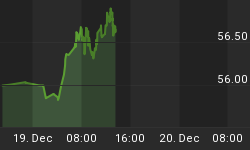In my previous commentary we examined some basic assumptions about manipulation in the precious metal markets. Since writing the first installment of this article a number of worthwhile responses have been received, some of which I'd like to share and comment on.
One reader responded as follows: "I am aware that gold and silver is being manipulated. Some good money has been made emulating their manipulation inversely. Praying that they continue to manipulate so that I can make some big money I could not make if they didn't."
The above is a point that I should have brought out more in my previous commentary on manipulation. In my recent article entitled "Greenspan has his eye on the gold market" I wrote, "This non-confirmation of the gold rally by the price of silver strongly suggests the recent rally has met its terminus." This forecast was made in part on the observation that the mainstream press (notably the London Financial Times) had gone bullish on gold, which definitely is out of the norm. The reader quoted above is correct in saying that by going opposite the manipulative practices of the insiders there is money to be made in gold and silver. That is, when the insiders use the press to lure the public into going long at a rally peak (or going short at a market bottom), a classic manipulation trap can be avoided by taking the opposite approach.
The Financial Times of London is an especially useful tool for gauging the manipulation campaigns of the market movers since they have perhaps the most impressive contact list of insiders. They have some of the highest inside sources among the manipulators and can always telegraph moves in gold/silver, stocks markets and foreign currencies in advance...if you know to take the contrarian approach of "reading between the lines" of this invaluable newspaper. Indeed, there is probably no better paper anywhere in the world for following the movements of the market manipulators than the Financial Times.
It's a pity to say this, but bewailing and lamenting the presence of manipulation in the gold and silver markets is just one way that some analysts have of excusing their lack of discernment and prognosticative ability. They get caught into the trap of the manipulators of buying at tops and selling at bottoms and then complain about "those darned manipulators" when they should know better.
Manipulation, as we established in the previous installment, is a fact of life in the financial markets - one that can't be avoided. You must simply learn to identify the tell-tale signs of market manipulation and then take a contrarian approach as the reader quoted above put it.
Regarding manipulation in the silver market, another reader responds, "The silver manipulation that is most easily seen is not through any chart. Is every piece of paper being bought and sold that is suppose to represent silver actually back by physical silver? No? Then the manipulation is through counterfeiting. People playing with paper silver are suppressing the price for those who actually own and hold real, physical silver. The real stuff. Leasing silver does not create more silver, yet they feel free to sell it? I will never get this as long as I live. Selling ice water futures in the desert does not quench anyone's thirst."

Ted Warren made his fortune in the stock market by identifying the activities of manipulators in the market for U.S. securities. In his famous book, "How to Make the Stock Market Make Money For You" he described a foray into commodities trading and how he used obvious attempts at manipulation within commodities futures to his own benefit. He describes the psychology and the manipulation behind various chart patterns and how they are used to create nervousness among traders and to shake out the "weak hands." Describing a particular triangle pattern in one futures contract he bought in 1946, he wrote, "It took powerful inside interests to support a high base like this. There could not have been a better setup for the Commodity Exchange Commission to investigate manipulation if they had wanted to."
Warren also made a point of stating that only those traders who are emotionally equipped to "read the tape between the lines" and spot manipulation should even be trading the futures markets.
The subject of manipulation is given an exhaustive treatment in the fascinating tome, "Wall Street Speculation - It's Tricks and It's Tragedies" by Franklin Keyes, written in 1904. Keyes observed, "When we come to consider the position of the insiders in the stock market, relative to that of the outsiders, it is very evident that with the insiders...the element of chance is practically eliminated."
He further wrote, "By making market conditions appear precisely the opposite of what they really are, the insiders keep the public on the losing side and put themselves on the winning side. This is the principal part of what is known as stock market manipulation and is accomplished in a hundred skillful and mysterious, too dark and devious to investigate here, in detail."
Keyes concludes, "In the end, it is true, the press arrives at the facts; but it is too late then for the speculator; he reads with empty pockets. The market has long since discounted the facts. Hence it follows that if one would get a correct idea of the...market situation from the newspapers, he must read it from between the lines..." Well put, Mr. Keyes.















